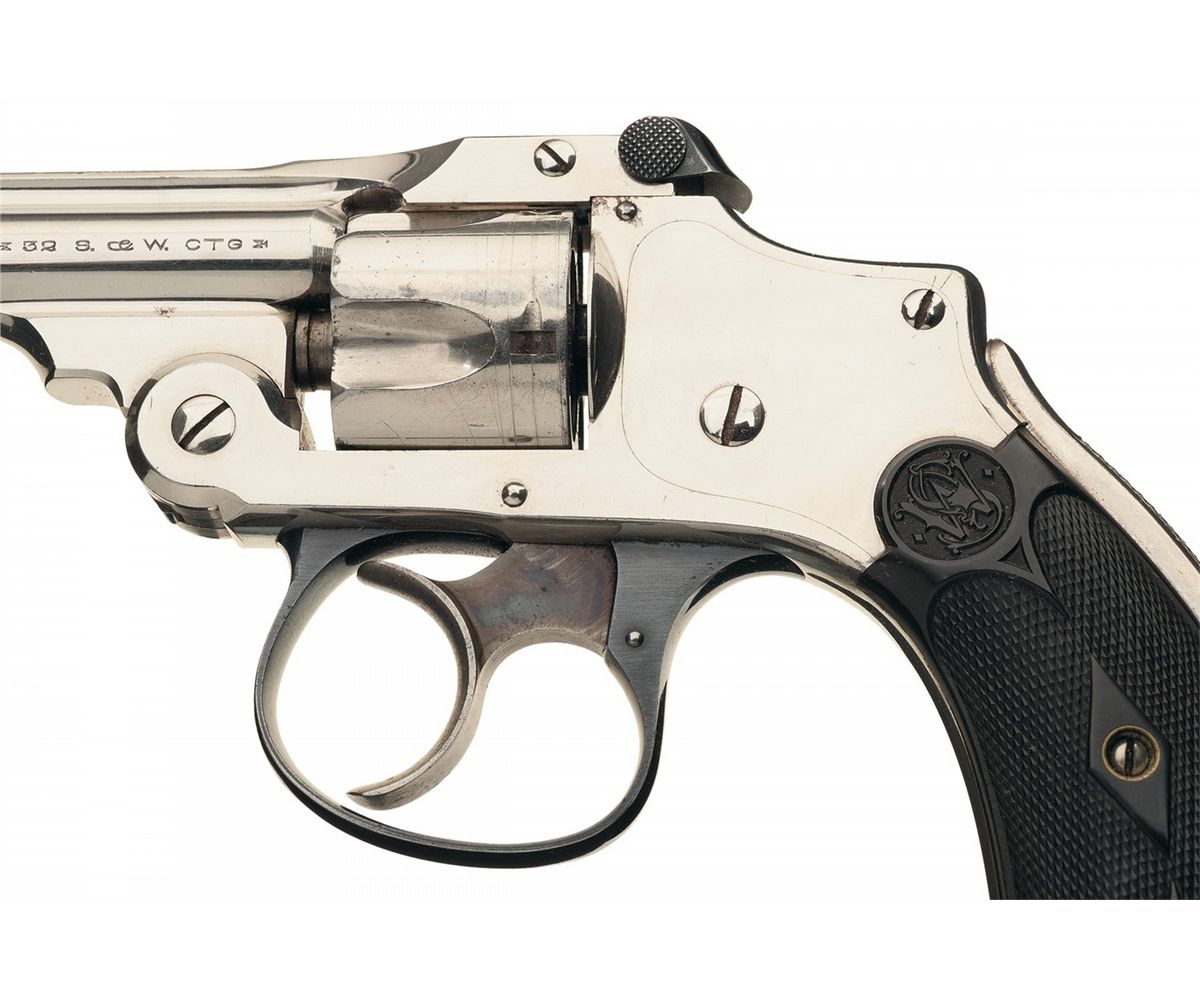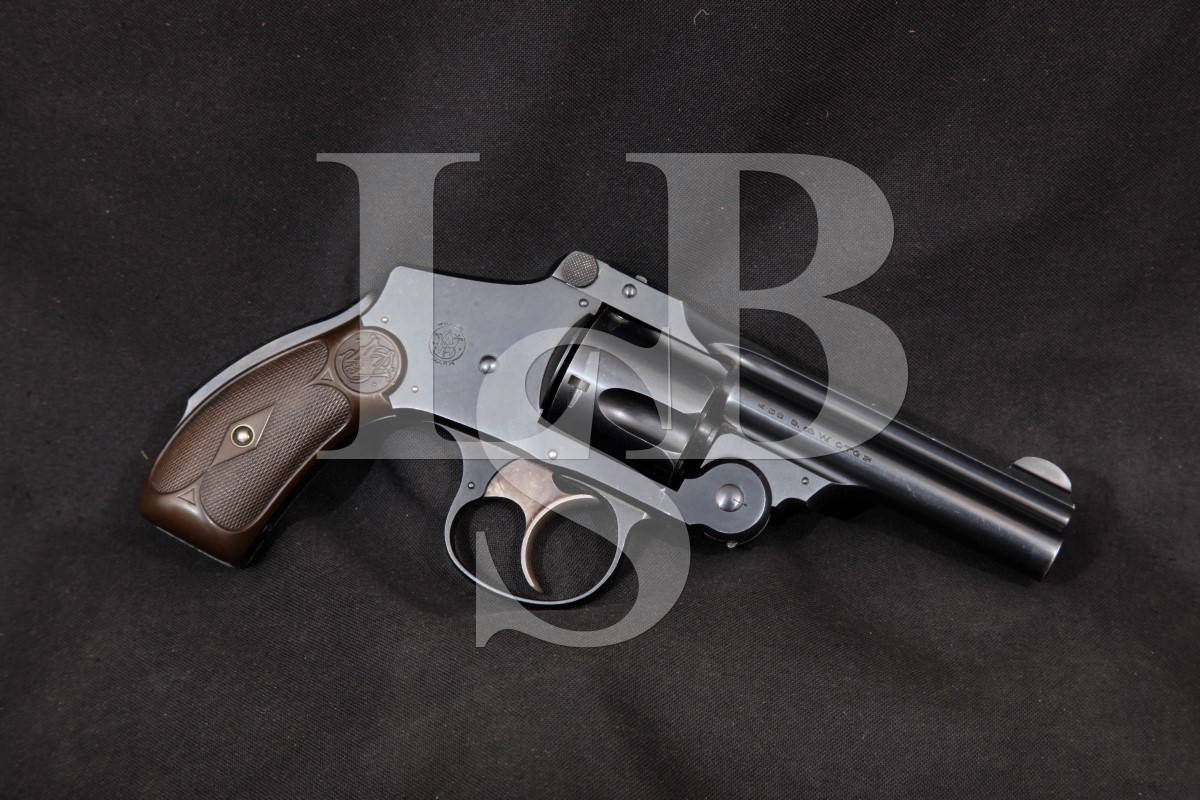Smith & Wesson
First model S&W Safety Hammerless.
The serial number puts the gun as having been made sometime around 1907, so to have a gun that is 112 years operate so well is even more astounding. The Smith & Wesson Safety Hammerless was. If it has a concealed hammer and a grip safety, it's a.32 Safety Hammerless 3rd Model, built 1909-1937; this gun was also known as a New Departure, or a 'Lemon Squeezer' in popular slang. As with other S&Ws dating from this time period, they were often built out of serial number order, so the only way to verify the actual age is to get a letter. Also known as the Lemon Squeezer, this is the third model.32 Safety Hammerless or 'lemon squeezer'. Single line address with Maltese crosses marked on top of the rib, and '+32 S.&W. CTG+' on the left side of the barrel. The Second Model is distinguished by the 'T' shaped barrel latch.
This revolver is made in 1887 total of 5125 revolvers.
It has a so called Z-bar. That's the latch for opening the revolver.
When you press it when the revolver is open you can remove the cylinder for cleaning.
The caliber is .38 S&W.
The pearl handles are factory.
Henk
Smith & Wesson 'Lemon Squeezer' .38 Safety Hammerless model
Based on the shape of the barrel latch, what we have here is a .38 Safety Hammerless model, a.k.a 'Lemon Squeezer'. Smith&Wesson issued 5 different variants of the .38 and 3 of the .32 caliber. There are only small variations, though.
The Safety Hammerless revolvers were the last of the topbreak series and come immediately before the Hand Ejector model with swing-out cylinder.
Production started in 1886 and the very last of these revolvers left the factory in 1940, long after production was resumed. The 3rd Model was introduced in 1890 at approx. serial# 42484 and was produced until 1898 (highest known serial# is 116002).
Your revolver is interesting because it is equipped with the quite scarce 6' barrel. Most of the production feature shorter barrels, the 2' one being nicknamed 'Bicycle Model'.

Technically, those revolvers were quite advanced because they included an 'inertia-type' firing pin, developed by Joe Wesson, son of Daniel B. This type of firing pin was mounted in the frame and spring-loaded. It could only hit the primer upon receiving a sufficient blow from the hammer, which transferred the momentum from the hammer to the firing pin itself. When the concealed hammer was at rest against the firing pin, the pin would not protrude through the frame.
I don't know who invented the system at first, but it wasn't Joe Wesson anyway. The 'inertia-type' firing pins were at the same period already in use in the Belgian Leclercq shotguns, and probably in numerous other weapons.
Marcel
Smith&Wesson Safety Hammerless 'Lemon Squeeze'
This revolver is a .38 caliber double-action Smith&Wesson Safety Hammerless, issued between 1898 and 1907 and also known as the 'lemon squeeze' due to the safety catch protruding at the rear of the grip frame. Collectors have distingue 5 models in this serial, all with minor variations. The conventional top-break barrel latch identifies it as the Fourth Model, made from 1898 to 1907. The serial numbers in this popular model started at 116.003 and ended with serial# 220.000. It was available in blue or nickel finish and was offered in a wide range of barrel lengths, form 2 to 6 inch.
Interesting and relatively inexpensive model. Still easily available today in perfect condition and in original cardboard box.
The company also issued the same model in the .32 caliber.
Marcel
| Smith & Wesson Safety Hammerless | |
|---|---|
| Type | Revolver |
| Place of origin | United States |
| Production history | |
| Manufacturer | Smith & Wesson |
| Produced | 1887-1940 |
| Specifications | |
| Caliber | .38 S&WBlackpowder .32 S&W |
| Action | Double Action |
| Feed system | 5-round cylinder |
| Sights | Fixed |

The Smith & Wesson Safety Hammerless or Smith & Wesson New Departure (nicknamed by collectors as the Lemon Squeezer) is a double-action revolver that was produced from 1887 to 1940 by Smith & Wesson. Based on the Smith & Wesson Model 2 double-action design, the revolver incorporated an internal hammer and an external grip safety on its back-strap. It was chambered in .32 S&W and .38 S&W calibers; these revolvers were discontinued prior to World War II, being eclipsed by the stronger hand ejector models.
.32 and .38 Safety Hammerless models[edit]
Smith And Wesson Safety Hammerless
The Smith & Wesson .38 Safety Hammerless models were produced from 1887 (1888 for the 32) to just before World War II. They were chambered in either .32 S&W or .38 S&W with a five-shot cylinder. They were most often produced with a 2-inch, 3-inch, or 3.5-inch barrels; but some 6' barrelled versions are known to exist.[1]
These top-break revolvers were designed for fast reloading and concealed carry as the hammer was internal and would not snag on drawing the revolver from a pocket. They were known as 'The New Departure' to reflect the company's new approach to designing revolvers.[1]
Smith & Wesson Hammerless 38
Minor design changes were made to these revolvers over the years, resulting in several different design models, as termed by collectors. The first model was manufactured from 1887 to 1902. The .38 was based on S&W's medium frame, while the .32 was based on the smaller sized '1½' frame.[2][3]
Return of the hammerless[edit]
S&w Safety Hammerless Serial Numbers
In 1952 the safety hammerless concept was applied to Smith & Wesson's J-frame. The finished product became the Model 40 and 42 chambered in .38 Special and is alternately known as the Smith & Wesson Centennial as it was produced in the 100th anniversary of the founding of Smith & Wesson.[1][4] While few competitors replicated the grip safety, the internal hammer or 'hammerless' design proved popular with other manufacturers such as Iver Johnson and Harrington & Richardson. The Centennial (without grip safeties) are still made by S&W, and have been copied by other revolver manufacturers.[1]
Smith & Wesson Hammerless 357

Technically, those revolvers were quite advanced because they included an 'inertia-type' firing pin, developed by Joe Wesson, son of Daniel B. This type of firing pin was mounted in the frame and spring-loaded. It could only hit the primer upon receiving a sufficient blow from the hammer, which transferred the momentum from the hammer to the firing pin itself. When the concealed hammer was at rest against the firing pin, the pin would not protrude through the frame.
I don't know who invented the system at first, but it wasn't Joe Wesson anyway. The 'inertia-type' firing pins were at the same period already in use in the Belgian Leclercq shotguns, and probably in numerous other weapons.
Marcel
Smith&Wesson Safety Hammerless 'Lemon Squeeze'
This revolver is a .38 caliber double-action Smith&Wesson Safety Hammerless, issued between 1898 and 1907 and also known as the 'lemon squeeze' due to the safety catch protruding at the rear of the grip frame. Collectors have distingue 5 models in this serial, all with minor variations. The conventional top-break barrel latch identifies it as the Fourth Model, made from 1898 to 1907. The serial numbers in this popular model started at 116.003 and ended with serial# 220.000. It was available in blue or nickel finish and was offered in a wide range of barrel lengths, form 2 to 6 inch.
Interesting and relatively inexpensive model. Still easily available today in perfect condition and in original cardboard box.
The company also issued the same model in the .32 caliber.
Marcel
| Smith & Wesson Safety Hammerless | |
|---|---|
| Type | Revolver |
| Place of origin | United States |
| Production history | |
| Manufacturer | Smith & Wesson |
| Produced | 1887-1940 |
| Specifications | |
| Caliber | .38 S&WBlackpowder .32 S&W |
| Action | Double Action |
| Feed system | 5-round cylinder |
| Sights | Fixed |
The Smith & Wesson Safety Hammerless or Smith & Wesson New Departure (nicknamed by collectors as the Lemon Squeezer) is a double-action revolver that was produced from 1887 to 1940 by Smith & Wesson. Based on the Smith & Wesson Model 2 double-action design, the revolver incorporated an internal hammer and an external grip safety on its back-strap. It was chambered in .32 S&W and .38 S&W calibers; these revolvers were discontinued prior to World War II, being eclipsed by the stronger hand ejector models.
.32 and .38 Safety Hammerless models[edit]
Smith And Wesson Safety Hammerless
The Smith & Wesson .38 Safety Hammerless models were produced from 1887 (1888 for the 32) to just before World War II. They were chambered in either .32 S&W or .38 S&W with a five-shot cylinder. They were most often produced with a 2-inch, 3-inch, or 3.5-inch barrels; but some 6' barrelled versions are known to exist.[1]
These top-break revolvers were designed for fast reloading and concealed carry as the hammer was internal and would not snag on drawing the revolver from a pocket. They were known as 'The New Departure' to reflect the company's new approach to designing revolvers.[1]
Smith & Wesson Hammerless 38
Minor design changes were made to these revolvers over the years, resulting in several different design models, as termed by collectors. The first model was manufactured from 1887 to 1902. The .38 was based on S&W's medium frame, while the .32 was based on the smaller sized '1½' frame.[2][3]
Return of the hammerless[edit]
S&w Safety Hammerless Serial Numbers
In 1952 the safety hammerless concept was applied to Smith & Wesson's J-frame. The finished product became the Model 40 and 42 chambered in .38 Special and is alternately known as the Smith & Wesson Centennial as it was produced in the 100th anniversary of the founding of Smith & Wesson.[1][4] While few competitors replicated the grip safety, the internal hammer or 'hammerless' design proved popular with other manufacturers such as Iver Johnson and Harrington & Richardson. The Centennial (without grip safeties) are still made by S&W, and have been copied by other revolver manufacturers.[1]
Smith & Wesson Hammerless 357
References[edit]
Hammerless Smith And Wesson
- ^ abcdSupica, Jim; Richard Nahas (2007). Standard Catalog of Smith & Wesson (3 ed.). Iola, Wisconsin: F+W Media, Inc. pp. 78–79, 151. ISBN978-0-89689-293-4.
- ^Shideler, Dan (2011). The Gun Digest Book of Guns & Prices 2011 Official Gun Digest Book of Guns and Prices (6 ed.). Gun Digest Books. p. 874. ISBN978-1-4402-1435-6.
- ^Flayderman, Norm (2007). Flayderman's Guide to Antique American Firearms and Their Values (9 ed.). F+W Media, Inc. p. 282. ISBN978-0-89689-455-6.
- ^Boorman, Dean K. (2002). The History of Smith & Wesson Firearms. Globe Pequot. p. 39. ISBN978-1-58574-721-4.
